[Click on any photo to enlarge.]
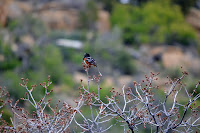 *Critters we’ve seen on our
2015 trip so far: elk, mule, mule deer, llama,
prairie dog, donkey
*Critters we’ve seen on our
2015 trip so far: elk, mule, mule deer, llama,
prairie dog, donkey
*Birds we’ve seen on our 2015
trip so far: California condor, Brewer’s blackbird, American kestrel, spotted towhee
*National Parks/Monuments visited on 2015 trip so far: 3
 Several
times over the past few years when putting together our plans for heading out west,
Mesa Verde National Park
(www.nps.gov/meve) was always on the list,
but it also always ended up being cut because it was a couple hundred miles out
of the way. This year we finally made
it, and this place was amazing! Having wanted to be an archaeologist at one point in my life, its history and preservation were exciting to see (though I wonder if I might have eventually gravitated to anthropology or geology since I have come to find them fascinating too!)
Several
times over the past few years when putting together our plans for heading out west,
Mesa Verde National Park
(www.nps.gov/meve) was always on the list,
but it also always ended up being cut because it was a couple hundred miles out
of the way. This year we finally made
it, and this place was amazing! Having wanted to be an archaeologist at one point in my life, its history and preservation were exciting to see (though I wonder if I might have eventually gravitated to anthropology or geology since I have come to find them fascinating too!)
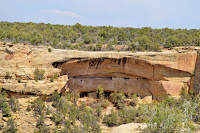 Located
in Colorado covering
81.4 sq. mi. and established in 1906, the park protects over 4,500 known
archaeological sites including 600 cliff dwellings. It provides a look into the lives of the
Ancestral Pueblo people (also known as the Anasazi) that lived there for over
700 years from AD 600 to 1300. The sites
are some of the best preserved in the U.S. like Sunset House pictured here which was
built on two levels consisting of 33 rooms.
Located
in Colorado covering
81.4 sq. mi. and established in 1906, the park protects over 4,500 known
archaeological sites including 600 cliff dwellings. It provides a look into the lives of the
Ancestral Pueblo people (also known as the Anasazi) that lived there for over
700 years from AD 600 to 1300. The sites
are some of the best preserved in the U.S. like Sunset House pictured here which was
built on two levels consisting of 33 rooms.
 We stayed
at the Morefield Camp-ground within the park which from mid to late April has
only one loop open, is first come first serve, and has no hookups or water. As we went around the campground loop, we noticed that there was basically only one site that was going to be big enough to fit us and that was
We stayed
at the Morefield Camp-ground within the park which from mid to late April has
only one loop open, is first come first serve, and has no hookups or water. As we went around the campground loop, we noticed that there was basically only one site that was going to be big enough to fit us and that was
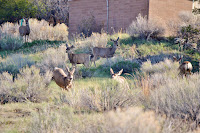 just barely! (Website said that there were sites big enough, but they must have been in the closed loops.) However we did have some very entertaining mule deer in the campground at some point nearly everyday, grazing, running, playing. Though the campground
just barely! (Website said that there were sites big enough, but they must have been in the closed loops.) However we did have some very entertaining mule deer in the campground at some point nearly everyday, grazing, running, playing. Though the campground
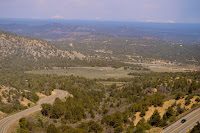 is only 4 miles from the park entrance,
you make your way up the mountain along narrow, winding switchbacks. (This view at left is actually looking back down the
mountain and that’s the visitor center about midway down all the way to the
right!)
is only 4 miles from the park entrance,
you make your way up the mountain along narrow, winding switchbacks. (This view at left is actually looking back down the
mountain and that’s the visitor center about midway down all the way to the
right!)
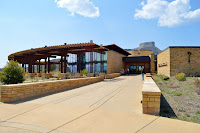 Elevations
in the park range from 6,900 ft. to 8,572 ft. with the visitor center being at
the base near the park entrance. This
relatively new and modern energy efficient building is also a research
facility. Out front is a cast bronze sculpture by Edward Fraughton titled "Ancient Ones" standing 20' 2" tall. It depicts an Ancestral
Elevations
in the park range from 6,900 ft. to 8,572 ft. with the visitor center being at
the base near the park entrance. This
relatively new and modern energy efficient building is also a research
facility. Out front is a cast bronze sculpture by Edward Fraughton titled "Ancient Ones" standing 20' 2" tall. It depicts an Ancestral
 Puebloan carrying a basket of corn climbing a Cliffside as he would have back in his day. The place doesn’t have many exhibits,
and we kept looking for where the orientation film would be shown. Finally asked and discovered that it’s
actually at the Chapin
Mesa Archeological
Museum, 22 miles from the
visitor center in the park, so that was our destination one day.
Puebloan carrying a basket of corn climbing a Cliffside as he would have back in his day. The place doesn’t have many exhibits,
and we kept looking for where the orientation film would be shown. Finally asked and discovered that it’s
actually at the Chapin
Mesa Archeological
Museum, 22 miles from the
visitor center in the park, so that was our destination one day.
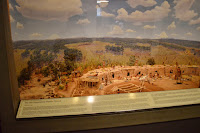 During
the summer there are two mesas (Chapin and Wetherill) with archaeological
sites, but the rest of the year only Chapin Mesa is open. From the outside the museum seems like a
small log cabin, but it actually has several rooms filled with dioramas, artifacts,
and exhibits. We watched the 25 min.
film that gave an overview of Mesa
During
the summer there are two mesas (Chapin and Wetherill) with archaeological
sites, but the rest of the year only Chapin Mesa is open. From the outside the museum seems like a
small log cabin, but it actually has several rooms filled with dioramas, artifacts,
and exhibits. We watched the 25 min.
film that gave an overview of Mesa
 Verde’s history and then wandered through
looking at many of the exhibits. One of
the most fascinating to me was this pottery that was discovered in the floor of
a small cave in 1955 filled with corn dating back to the 1200s. The corn kernels are those actually found in
that jar which had been buried up to its neck with the small bowl turned upside
down as a lid keeping out insects and vermin.
The corn weighs 31 lbs. 4 oz. and measures about 22 quarts.
Verde’s history and then wandered through
looking at many of the exhibits. One of
the most fascinating to me was this pottery that was discovered in the floor of
a small cave in 1955 filled with corn dating back to the 1200s. The corn kernels are those actually found in
that jar which had been buried up to its neck with the small bowl turned upside
down as a lid keeping out insects and vermin.
The corn weighs 31 lbs. 4 oz. and measures about 22 quarts.
 Out back
is the Spruce Tree House, the park’s best preserved cliff dwelling. These types of homes were built in shallow
caves and under the canyon’s rock overhangs during the last 75 to 100 years of
occupation in the region. Spruce Tree, built
sometime between AD 1211 and 1278, contains roughly
Out back
is the Spruce Tree House, the park’s best preserved cliff dwelling. These types of homes were built in shallow
caves and under the canyon’s rock overhangs during the last 75 to 100 years of
occupation in the region. Spruce Tree, built
sometime between AD 1211 and 1278, contains roughly
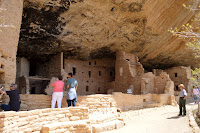 130 rooms, and one can take
a self-guided tour though some areas are off limits (two rangers are located at
the site to answer questions). To reach
it involves walking down a paved winding path about a 100 ft. below the museum
for a 1/2 mile round trip. Russ decided
to wait up top for me
130 rooms, and one can take
a self-guided tour though some areas are off limits (two rangers are located at
the site to answer questions). To reach
it involves walking down a paved winding path about a 100 ft. below the museum
for a 1/2 mile round trip. Russ decided
to wait up top for me
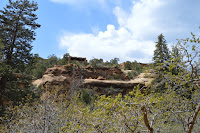 while I made the descent down to the site (view from the
House looking back up is at right). The
construction is quite remarkable especially when you consider when it was built
(90% is original), though there is varying degrees of decay as would be
expected. The roof on one of the kivas
has been
while I made the descent down to the site (view from the
House looking back up is at right). The
construction is quite remarkable especially when you consider when it was built
(90% is original), though there is varying degrees of decay as would be
expected. The roof on one of the kivas
has been
 restored by the park service, and there is a ladder that descends 6
feet down into the chamber. I started to
take a picture when I suddenly saw a hand on one of the rungs which surprised
me as I had assumed you couldn’t go down there.
Well, of course, I had to go down and check it out. These
restored by the park service, and there is a ladder that descends 6
feet down into the chamber. I started to
take a picture when I suddenly saw a hand on one of the rungs which surprised
me as I had assumed you couldn’t go down there.
Well, of course, I had to go down and check it out. These
 round underground chambers were
probably used for religious and/or social purposes with a roof made of log,
mud, and stone (more on them later). I
was glad that I had made the walk down to Spruce Tree House to see this
incredible archaeological site up close.
round underground chambers were
probably used for religious and/or social purposes with a roof made of log,
mud, and stone (more on them later). I
was glad that I had made the walk down to Spruce Tree House to see this
incredible archaeological site up close.
 Prior to cliff dwellings, the Ancestral Pueblo people
lived mainly on top of the mesas in pit houses generally gathered together in
small villages eventually building above ground pole and mud houses. The population flourished as they farmed,
hunted, and
Prior to cliff dwellings, the Ancestral Pueblo people
lived mainly on top of the mesas in pit houses generally gathered together in
small villages eventually building above ground pole and mud houses. The population flourished as they farmed,
hunted, and
 became proficient at making pottery and baskets. There are many stops and loop roads along the
Chapin Mesa road where you can view some of the remains of these surface sites
dating back to AD 600, some with only the dug out ground and others partially still standing above ground. Some of
became proficient at making pottery and baskets. There are many stops and loop roads along the
Chapin Mesa road where you can view some of the remains of these surface sites
dating back to AD 600, some with only the dug out ground and others partially still standing above ground. Some of
 these are
found at the Far View Sites Complex where nearly 50 villages have been
identified within a half square mile area.
It’s believed that people were living here about 200 years before they
began building the cliff dwellings. At
left is just one of the houses of the few we saw.
these are
found at the Far View Sites Complex where nearly 50 villages have been
identified within a half square mile area.
It’s believed that people were living here about 200 years before they
began building the cliff dwellings. At
left is just one of the houses of the few we saw.
 Of course
the big draw and fascination are the cliff dwellings, and there are plenty of
them easily seen from the road or the overlooks, much more so than at Canyon de
Chelly. The largest and most famous of
the cliff dwellings at Mesa Verde is Cliff
Palace consisting of 150
rooms and 23 kivas. It is 1 of 3
dwellings that
Of course
the big draw and fascination are the cliff dwellings, and there are plenty of
them easily seen from the road or the overlooks, much more so than at Canyon de
Chelly. The largest and most famous of
the cliff dwellings at Mesa Verde is Cliff
Palace consisting of 150
rooms and 23 kivas. It is 1 of 3
dwellings that
 can only be visited on a guided ranger tour, but this spring it
was closed to tours because of some preservation work the park service was
doing on it. We did have a great view of
it from across the canyon (that’s what I’m motioning to in the photo), then I
zoomed in with the camera so you can have a better look.
can only be visited on a guided ranger tour, but this spring it
was closed to tours because of some preservation work the park service was
doing on it. We did have a great view of
it from across the canyon (that’s what I’m motioning to in the photo), then I
zoomed in with the camera so you can have a better look.
Another
of the tour dwellings is Long House, but it’s on the road that’s only open
during the summer. And last but not
least is Balcony House, considered the most adventurous of the cliff dwelling
tours…but more on that in the next post!

3 comments:
Been there numerous times. So much history. Glad you got to experience it. We were able to tour all. Some definitely more challenging.
WOW ! amazing historical insight. The American Indians really get slighted in our history books. No televisions, computers, I pads-----they spent their days building cave dwellings. Could get boring after awhile. Russ and I would probably have been the reprobates who introduced them to whiskey! Fred
Do they still have that open-ended box to check your size and flexibility near the ticket window? If you are too wide to crawl through or not flexible enough to get down on your hands and knees to crawl through, there was a time when they wouldn't sell you a ticket. On our last tour, a lady said she thought they were just kidding about the tight squeezes and tall ladders. She was afraid of heights. It didn't go well for her.
Post a Comment